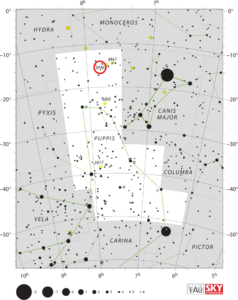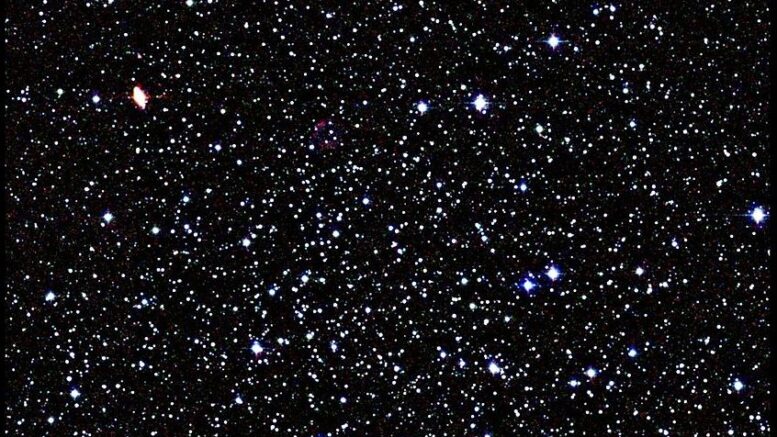M46 is a rich open cluster, easily visible with binoculars, that’s located in the Milky Way star fields of the constellation of Puppis. The cluster is a relatively large object with an apparent diameter almost equal to that of the full Moon. It was discovered by Charles Messier on February 19, 1771 and is best seen from southern and equatorial latitudes during the months of December, January and February.
| Description | |
| Visible From Pacific Northwest | October To March |
| Best Time To Observe | January |
| Minimum Size Of Viewing Device | Small Telescope |
| Object Type | Open Cluster |
| Designations | Messier 46, M46, NGC 2437, Collinder 159, C 0739-147, OCl 601.0, MWSC 1313 |
| Right Ascension | 07h 41.8m |
| Declination | -14°49′ |
| Constellation | Puppis |
| Number Of Stars | 500 |
| Apparent magnitude | +6.1 |
| Apparent dimensions | 27′ |
| Object Radius | 15 light years |
| Distance From Earth | 5,400 light years |
History
Messier 46 was one of Charles Messier’s original discoveries. Messier first observed the cluster in 1771, after he had already published the first edition of his catalogue. He added M46, M47, M48 and M49 to the list on February 19, 1771, only three days after presenting his catalogue to the academy.
Messier described M46 as a “cluster of very small stars, between the head of the Great Dog [Canis Major] and the two hind feet of the Unicorn [Monoceros], [its position] determined by comparing this cluster with the star 2 Navis, of 6th-magnitude, according to Flamsteed; one cannot see these stars but with a good refractor; the cluster contains a bit of nebulosity.”
Locating M46 In The Sky
There is no simple way of finding Messier 46 in the finderscope of a telescope, but it’s not too hard with binoculars. Begin your hunt a little more than a fistwidth east/northeast of bright Sirius (Alpha Canis Majoris)… or about 5 degrees (3 finger widths) south of Alpha Monoceros. There you will find two open clusters that will usually appear in the same average binocular field of view. M46 is the easternmost of the pair.

Viewing M46
Messier 46 is easy to see in binoculars and small telescopes. It can be found using Sirius, the brightest star in the night sky, as it lies roughly in the same area. M46 is located 14 degrees east and 2 degrees north of the Dog Star. In 10×50 binoculars, the cluster appears hazy and almost like a nebula, but larger binoculars reveal a large open cluster with about 50 dim stars. Larger telescopes show a field of faint stars that are very similar in brightness.
Photographing M46
Messier 46 has a variety of ways to image, but as it can be harder to view with smaller telescopes, larger telescopes with autoguiding will be required. The time and filters will vary depending on setup, but accurate autoguiding is crucial as it will need to be on point to remain crisp.
https://www.cloudynights.com/gallery/image/24563-open-cluster-m46-with-planetary-nebula-ngc2438/
https://www.cloudynights.com/topic/531786-m46-and-ngc-2438/
Sources And Further Reading
Descriptions of all of Messier Objects can be found here.
https://www.messier.seds.org/m/m046.html
https://freestarcharts.com/messier-46

Be the first to comment on "Messier 46"